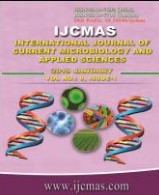


 National Academy of Agricultural Sciences (NAAS)
National Academy of Agricultural Sciences (NAAS)

|
PRINT ISSN : 2319-7692
Online ISSN : 2319-7706 Issues : 12 per year Publisher : Excellent Publishers Email : editorijcmas@gmail.com / submit@ijcmas.com Editor-in-chief: Dr.M.Prakash Index Copernicus ICV 2018: 95.39 NAAS RATING 2020: 5.38 |
Dermatophytosis refers to superficial fungal infection of keratinized tissues, caused by group of keratinophilic dermatophytes. The prevalence of dermatophyte infection varies with different geographic area and climatic conditions. It is one of the common fungal infection but in recent times it is one of the neglected disease. The present study was aimed to assess the clinicomycological profile of dermatophytosis to identify the various infecting dermatophyte species and to compare clinical diagnosis with KOH microscopy and culture. A total of 198 clinically diagnosed cases of dermatophytosis were subjected to study during one year of. Specimens collected were skin scraping, nail clipping, and hair samples subjected to direct microscopy by KOH and fungal culture. During this study KOH microscopy revealed fungal elements in (54.04%) cases while culture was positive in (43.4%). Males were predominantly affected (77.2%) as compared to female (22.8%) and common age group affected was 21-30 years (38.2%). Tinea corporis (50%). was commonest clinical presentation. Trichophyton rubrum (65.09%) was most common isolates followed by Trichophyton mentagrophytes (18.1%). Among the dermatophytic skin infection, Tinea scorporis was the predominant clinical type and T. rubrum was most common isolate. Species level identification was necessary for epidemiological purpose and treatment.
 |
 |
 |
 |
 |